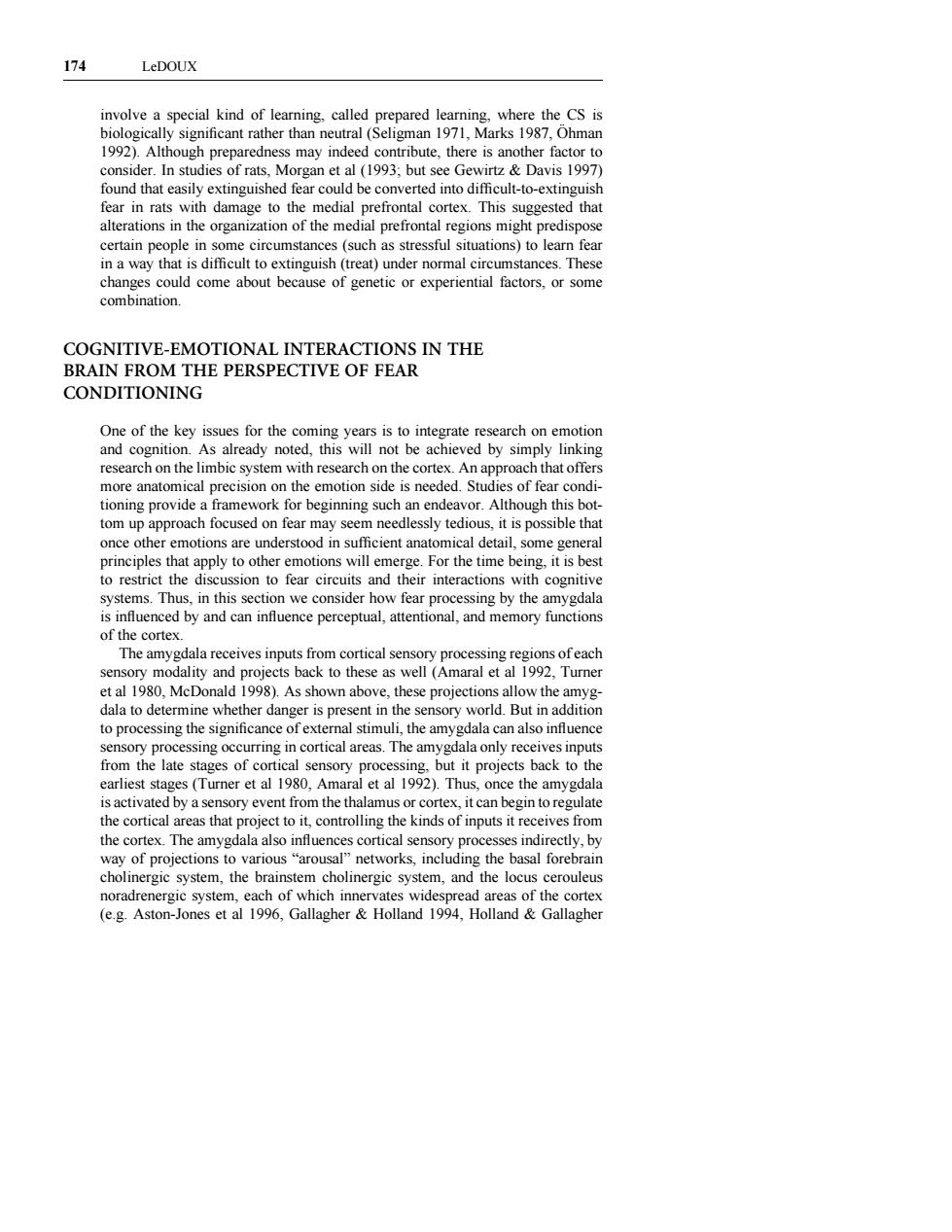正在加载图片...

174 LeDOUX involve a special kind of learning.called prepared learning.where the CS is rather than neutral (Seligman 1971.Marks198.Ohman 992 prepare may ind found that easily extinguished fear could be converted into difficult-to-extinguish fear in rats with damage to the medial prefrontal cortex.This suggested that organization of the med The changes could come about because of genetic or experiential factors,or some combination. COGNITIVE-EMOTIONAL INTERACTIONS IN THE BRAIN FROM THE PERSI PECTIVE OF E FEAR CONDITIONING One of the key issues for the coming vears is to integrate esearch on emotiot and cognition.As already noted,this will not be achieved by simply linking research on the limbic system with research on the corte .An approach that offers more anaton once other emotions are understood in sufficient anatomical detail,some general principles that apply to other emotions will emerge.For the time b ng.it is bes s Thus in this sider how fear p he isinenced by and can inc perceptual,attentionland memory function of the cortex. la rec The amy ali eivesin cortical sen proce ell etal 1980.McDonald 1998)As shown above.these proiections allow the amvg dala to determine whether danger is present in the sensory world.But in addition to processing the signifi of external stimu the amygdala can also infuence cts back to the earliest stages (Turner et al 1980,Amaral et al 1992).Thus,once the amygdala is activated by a sensory event from the thalamus or cortex,it can begin to regulate way of projections to various"arous the bsa forer cholinergic system,the brainstem cholinergic system,and the locus cerouleus (e.g.Aston- 99174 LeDOUX involve a special kind of learning, called prepared learning, where the CS is biologically significant rather than neutral (Seligman 1971, Marks 1987, O¨ hman 1992). Although preparedness may indeed contribute, there is another factor to consider. In studies of rats, Morgan et al (1993; but see Gewirtz & Davis 1997) found that easily extinguished fear could be converted into difficult-to-extinguish fear in rats with damage to the medial prefrontal cortex. This suggested that alterations in the organization of the medial prefrontal regions might predispose certain people in some circumstances (such as stressful situations) to learn fear in a way that is difficult to extinguish (treat) under normal circumstances. These changes could come about because of genetic or experiential factors, or some combination. COGNITIVE-EMOTIONAL INTERACTIONS IN THE BRAIN FROM THE PERSPECTIVE OF FEAR CONDITIONING One of the key issues for the coming years is to integrate research on emotion and cognition. As already noted, this will not be achieved by simply linking research on the limbic system with research on the cortex. An approach that offers more anatomical precision on the emotion side is needed. Studies of fear conditioning provide a framework for beginning such an endeavor. Although this bottom up approach focused on fear may seem needlessly tedious, it is possible that once other emotions are understood in sufficient anatomical detail, some general principles that apply to other emotions will emerge. For the time being, it is best to restrict the discussion to fear circuits and their interactions with cognitive systems. Thus, in this section we consider how fear processing by the amygdala is influenced by and can influence perceptual, attentional, and memory functions of the cortex. The amygdala receives inputs from cortical sensory processing regions of each sensory modality and projects back to these as well (Amaral et al 1992, Turner et al 1980, McDonald 1998). As shown above, these projections allow the amygdala to determine whether danger is present in the sensory world. But in addition to processing the significance of external stimuli, the amygdala can also influence sensory processing occurring in cortical areas. The amygdala only receives inputs from the late stages of cortical sensory processing, but it projects back to the earliest stages (Turner et al 1980, Amaral et al 1992). Thus, once the amygdala is activated by a sensory event from the thalamus or cortex, it can begin to regulate the cortical areas that project to it, controlling the kinds of inputs it receives from the cortex. The amygdala also influences cortical sensory processes indirectly, by way of projections to various “arousal” networks, including the basal forebrain cholinergic system, the brainstem cholinergic system, and the locus cerouleus noradrenergic system, each of which innervates widespread areas of the cortex (e.g. Aston-Jones et al 1996, Gallagher & Holland 1994, Holland & Gallagher